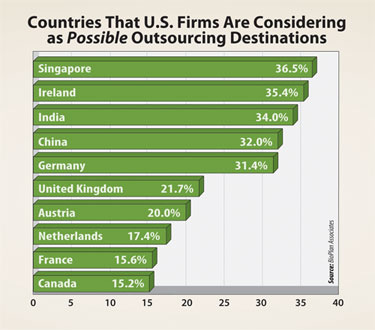산업동향
Realistic Expectations Likely to Prevail in 2010
- 등록일2010-03-15
- 조회수4607
- 분류산업동향 > 종합 > 종합
-
자료발간일
2010-03-01
-
출처
GEN
- 원문링크
-
키워드
#biotech industry
Realistic Expectations Likely to Prevail in 2010
As Economy Recovers, Firms in Sector Remain Cautiously Optimistic about Future Growth

Countries that U.S. firms are considering as possible outsourcing destinations
The biotech industry is starting the new decade with good reason for cautious optimism. Based on results from our current 7th Annual Report and Survey of Biomanufacturing, most companies are more confident, but also more realistic: 2010 will bring good results, but managers are expecting better performance from the same staff. Some of last year’s budgetary shifts are becoming solid trends that are defining how biopharma will evolve over the next few years. Key developments in 2010 will include advances in science, technology, the economy, and regulations.
Biopharmaceuticals: Biologics will continue to be primary targets for both the biotechnology and pharmaceutical industries. The number and percentage of biopharmaceuticals and the contributions of these drugs to the profits of the pharmaceutical industry will continue to increase. Expanded investments in biopharmaceutical R&D simply make sense, with these products increasingly the source for profits as loss of patent protection and generic competition erode mainstream pharmaceutical industry profits.
Biopharma approvals: 2010 will see an increased number of biopharmaceuticals entering major markets. FDA approvals of biopharmaceuticals increased in 2009, reversing a trend of low and decreasing numbers. Over 60 biopharmaceutical products currently have applications either pending or expected to be filed in 2010, joining over 335 currently approved by FDA. Many of these will receive prompt approvals.
Biosimilars are coming: Legislation enabling abbreviated, comparison-based, generic drugs—like FDA’s approvals pathway for biologics—will be enacted. Although it will take several years for FDA to fully implement related regulations, with the U.S. market more receptive to biosimilars and other me-too products, there will be a significant increase in the number of biosimilars in development and companies entering this field.
Biosimilars will significantly expand the number of companies active in R&D and manufacturing. This will include an increasing number of foreign companies, many based in developing countries, seeking to develop biosimilars for the U.S. market.
Cost-containment: Governments in the U.S. and other major pharmaceutical markets will continue efforts to reduce costs. This will involve integration of cost-effective assessments in approval and insurance coverage decisions, including U.S. healthcare delivery regulators getting involved more often. Therapeutics will need to show improvement and cost savings relative to competing products.
Bioprocessing: Many recent trends in bioprocessing, particularly biopharmaceutical manufacturing, will continue. Companies will continue to invest in expansion of manufacturing capacity, with increased attention, and investments will be made to resolve bottlenecks in downstream purification. Experienced bioprocessing professionals will continue to be in demand in 2010, as senior staff (babyboomers) start to retire.
Bioprocessing technologies: Cost-containment will continue to drive progress, led by the adoption of new technologies, improved yields from upstream processing, and better expression systems, host cells and genetic-engineering technologies for large-scale manufacture. All will improve not only manufacturing processes, but quality, and even clinical performance. Upstream expression yields will continue to increase, and downstream purification will continue to struggle to keep up.
Industry consolidation: Merging and purging among companies will likely increase. Larger companies, particularly Big Pharma with ailing R&D pipelines, will continue to acquire smaller firms and merge among themselves, along with consolidation, post-merger downsizing, and layoffs. This has been a short-term fix or distraction for many companies’ experiencing problems with internal innovation, particularly the failure to develop new blockbusters needed to replace the many products coming off patent.
R&D independence: While organizational consolidation continues, the trend of large companies seeking to repackage their R&D programs as more independent, entrepreneurial-type efforts will continue. There will be increased questioning of whether consolidation, particularly among large companies, is actually a prudent strategy.
Internationalization: The growth in biotechnology, particularly biopharmaceutical markets will continue worldwide, with much expansion in China, India, and other rapidly developing countries where middle classes are expanding and exerting demand through their increasing affluence. Manufacturing capacity and R&D will continue to increase rapidly worldwide, including in developing countries.
Economy, spending, and outsourcing: The world economy will continue its slow recovery, while investments in biopharmaceutical manufacturing capacity and R&D will continue to increase. Despite this, companies will universally continue to cut back internally. Noncritical R&D and manufacturing will be outsourced and offshored or transferred to other countries offering lower labor and other costs. However, we are already seeing a slowing of this trend, as worldwide demand for experienced professionals and increasing growth and affluence in many foreign countries reduce the cost savings from offshoring.
New technologies in the market: 2010 could well see the first U.S. and other major market approvals of therapeutic technologies that have long been stalled in development, including gene therapy and cancer vaccines. Personalized medicine will continue to advance slowly, with more diagnostics being used to guide selective use of biopharmaceuticals, increasing efficacy for qualifying patients and decreasing overall healthcare costs.
Influenza vaccines: Recent experience with the H1N1 influenza epidemic and vaccines may adversely affect the growth of the market for influenza and, to a lesser extent, other vaccines. With the press, governments, and public-health establishment possibly having overstressed the threat from H1N1 influenza and with vaccines arriving late, many will continue to avoid getting vaccinated, and future large-scale public vaccination programs may be more difficult to mount.
Overall, 2010 will be a good year for the biotechnology and biopharmaceutical industries. The firms that remain will be viable, relatively insulated, and in a position for solid future growth.

